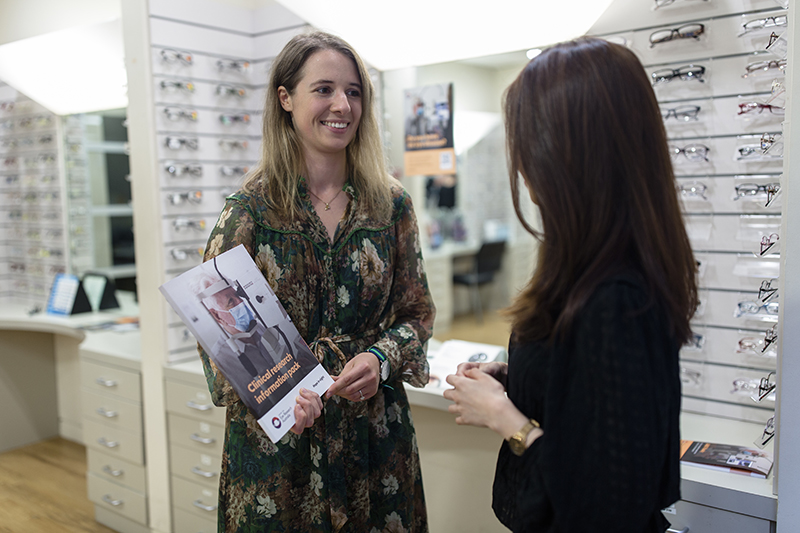Stories
Meet our researchers: Dr Emily Glover
For World Optometry Day, we’re celebrating optometrists such as Dr Emily Glover – a Clinical Trials Coordinator in our Macular Research team who is helping other optometrists have a big impact on our research.
How did you get into optometry?
I studied a Bachelor of Biomedicine at the University of Melbourne, followed by a Doctor of Optometry. What inspired me to study optometry is that eyesight is one of the most important senses and this profession gives me the opportunity to help patients and have an impact on their daily lives.
During my studies, I was one of three students awarded the Judy Glover Memorial Scholarship (no relation!), which took us outside of Broome in northern Western Australia. We did vision testing for Indigenous communities with Lions Outback Vision. They had an ophthalmologist on board that could do some of the treatments on the spot. This was a wonderful and eye-opening experience to see eyecare management in different environments.
It was good to see how eye health is managed in different settings, because it’s easy in a big city where all you need is a referral to see a specialist. But people living in remote WA have to travel on a Royal Flying Doctors service if they need to go to hospital.
I also had an internship in Connecticut in the United States, where I developed my skills testing patients using advanced imaging technology. That served as good experience for my current role as a clinical trials coordinator, where imaging needs to be spot-on perfect.
What inspired you to get into research?
As an optometrist, I was good at helping individual patients with their eye care management. But with research, I could potentially help many people living with eye conditions.
After working in optometry for a few years, I considered studying a PhD and found out through the University of Melbourne there were research assistant opportunities with CERA. I was really happy with my choice to move into research, and I think it’s a great opportunity others can get involved with.
What research are you involved with in the Macular Research Unit?
I’m involved in recruiting people who have the dry form of age-related macular degeneration (AMD) for our studies and coordinating a natural history study where I see participants every three months.

What do you typically do with a patient during clinical studies?
I take people through questionnaires about their day-to-day life with macular degeneration, check their vision, dilate their eyes and record their eye pressure. I also do visual field testing and use imaging devices to look at their eyes and assess their level of macular degeneration.
What’s great is that many participants enjoy coming in, and it gives them a regular check-in to see where their eyes are at. And I can give them regular updates to see if they’re eligible for any other clinical trials.
I’m currently screening patients referred from optometry clinics for our clinical studies – just to gauge where they’re at and what they’re eligible for.
How can optometrists help our vision research?
Optometrists can bring a lot to the table. We need to catch patients with the earliest signs of dry AMD for our studies, and these people are most likely to see optometrists. People who are further along with their eye condition are often more likely to see an ophthalmologist.
Over the years, the Macular Research Unit has been trying in different ways to encourage easier referral pathways for patients. The Optometry Referral Network empowers patients to make an informed decision about becoming involved in our clinical research in a quicker and easier way.
I really enjoy going out to clinics and special events, where I talk to optometrists about what’s going on with our macular research. I offer them referral pads, which they can get patients to fill out if they’d like to register their interest for our AMD studies.
Do you think it’s important to still have a foot in the clinical world when you’re working in research?
For me, it’s good keeping up my skills and speaking to patients directly. Working at CERA has changed my management strategy for some patients because I can now offer people with dry AMD the option of participating in research.
What’s your proudest moment working at CERA?
Last year, I attended the annual Southern Regional Congress optometry conference. I created and presented a poster with optometry colleagues about the landmark LEAD study, which investigated whether using a ‘nanosecond’ laser could slow down the rate of AMD progression, from early to late stages. I’m grateful to Professor Robyn Guymer AM for the opportunity.
I enjoy working at CERA and interacting with our regular participants and the team – it’s a great environment to work in.
